因果神经符号人工智能:因果关系与神经符号方法的协同作用
IF 6.1
3区 计算机科学
Q1 COMPUTER SCIENCE, ARTIFICIAL INTELLIGENCE
引用次数: 0
摘要
因果神经符号人工智能(NeSyAI)结合了因果性和 NeSyAI 的优点。更具体地说,它:1)用明确的因果关系表示丰富了 NeSyAI 系统;2)将因果知识与领域知识整合在一起;3)使 NeSyAI 技术能够用于因果人工智能任务。显式因果关系表征能提供预测模型可能无法从观察数据中分析出的见解。它还能在决策场景中为人们提供帮助,在决策场景中,人们需要辨别结果的原因,以便在各种干预措施中做出选择。本文章由计算机程序翻译,如有差异,请以英文原文为准。
Causal Neurosymbolic AI: A Synergy Between Causality and Neurosymbolic Methods
Causal neurosymbolic AI (NeSyAI) combines the benefits of causality with NeSyAI. More specifically, it 1) enriches NeSyAI systems with explicit representations of causality, 2) integrates causal knowledge with domain knowledge, and 3) enables the use of NeSyAI techniques for causal AI tasks. The explicit causal representation yields insights that predictive models may fail to analyze from observational data. It can also assist people in decision-making scenarios where discerning the cause of an outcome is necessary to choose among various interventions.
求助全文
通过发布文献求助,成功后即可免费获取论文全文。
去求助
来源期刊

IEEE Intelligent Systems
工程技术-工程:电子与电气
CiteScore
13.80
自引率
3.10%
发文量
122
审稿时长
1 months
期刊介绍:
IEEE Intelligent Systems serves users, managers, developers, researchers, and purchasers who are interested in intelligent systems and artificial intelligence, with particular emphasis on applications. Typically they are degreed professionals, with backgrounds in engineering, hard science, or business. The publication emphasizes current practice and experience, together with promising new ideas that are likely to be used in the near future. Sample topic areas for feature articles include knowledge-based systems, intelligent software agents, natural-language processing, technologies for knowledge management, machine learning, data mining, adaptive and intelligent robotics, knowledge-intensive processing on the Web, and social issues relevant to intelligent systems. Also encouraged are application features, covering practice at one or more companies or laboratories; full-length product stories (which require refereeing by at least three reviewers); tutorials; surveys; and case studies. Often issues are theme-based and collect articles around a contemporary topic under the auspices of a Guest Editor working with the EIC.
 求助内容:
求助内容: 应助结果提醒方式:
应助结果提醒方式:


